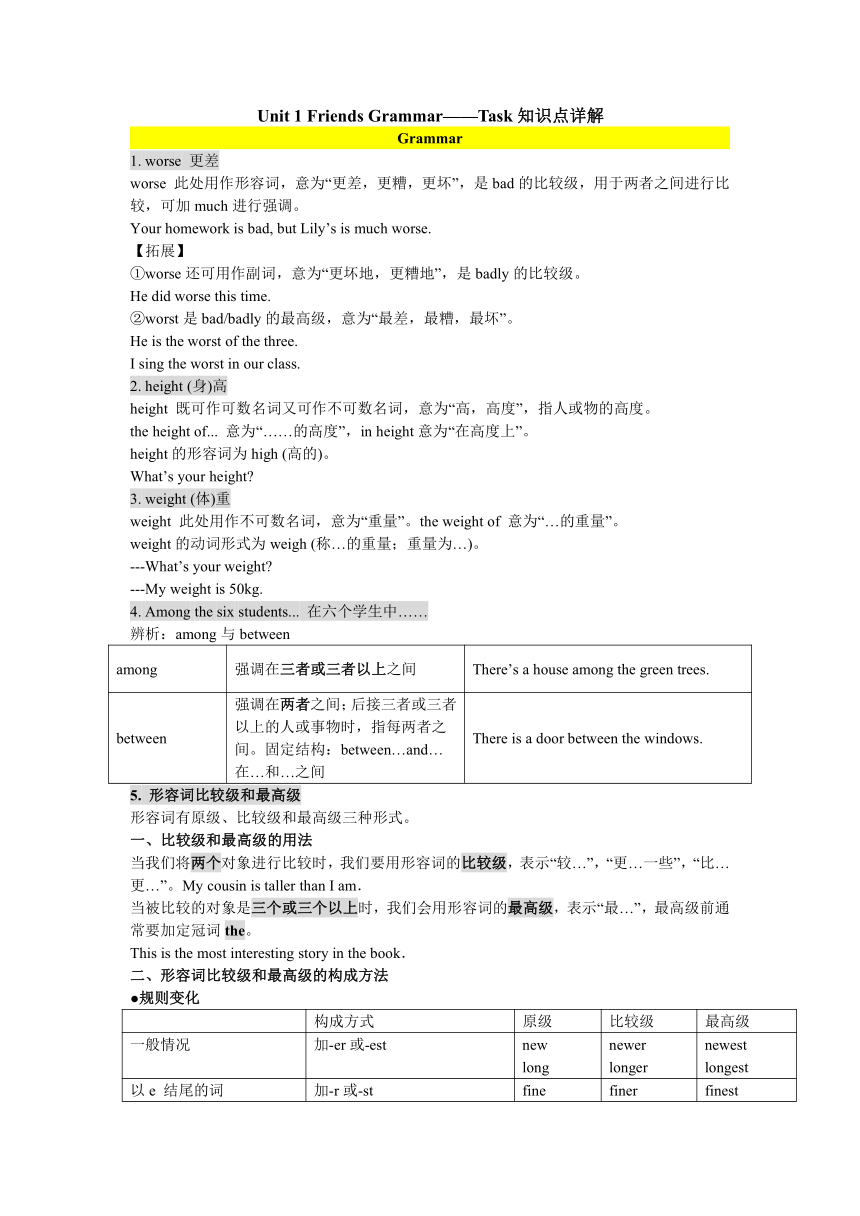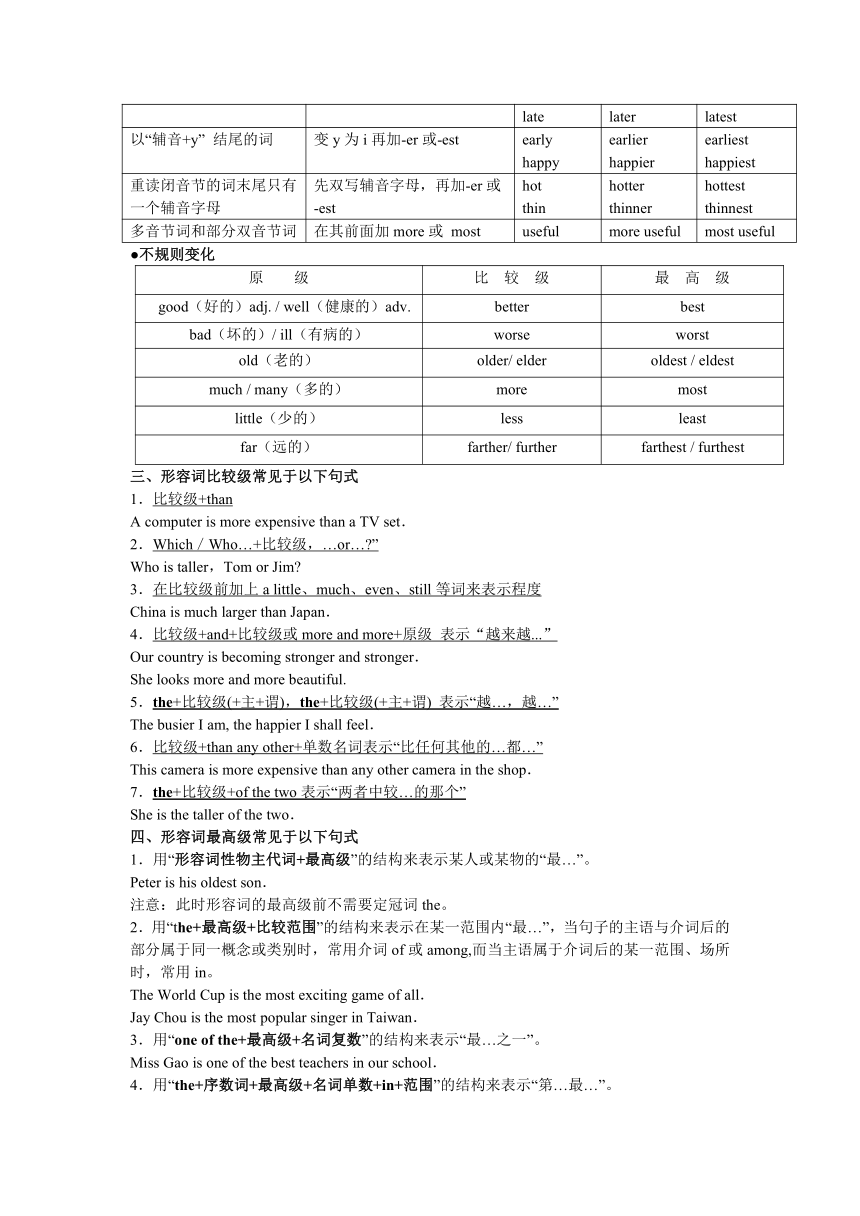2022-2023学年牛津译林版英语八年级上册 Unit 1 Friends Grammar Task 知识点详解
文档属性
| 名称 | 2022-2023学年牛津译林版英语八年级上册 Unit 1 Friends Grammar Task 知识点详解 |  | |
| 格式 | docx | ||
| 文件大小 | 31.8KB | ||
| 资源类型 | 教案 | ||
| 版本资源 | 牛津译林版 | ||
| 科目 | 英语 | ||
| 更新时间 | 2023-08-23 17:47:07 | ||
图片预览


文档简介
Unit 1 Friends Grammar——Task知识点详解
Grammar
1. worse 更差
worse 此处用作形容词,意为“更差,更糟,更坏”,是bad的比较级,用于两者之间进行比较,可加much进行强调。
Your homework is bad, but Lily’s is much worse.
【拓展】
①worse还可用作副词,意为“更坏地,更糟地”,是badly的比较级。
He did worse this time.
②worst是bad/badly的最高级,意为“最差,最糟,最坏”。
He is the worst of the three.
I sing the worst in our class.
2. height (身)高
height 既可作可数名词又可作不可数名词,意为“高,高度”,指人或物的高度。
the height of... 意为“……的高度”,in height意为“在高度上”。
height的形容词为high (高的)。
What’s your height
3. weight (体)重
weight 此处用作不可数名词,意为“重量”。the weight of 意为“…的重量”。
weight的动词形式为weigh (称…的重量;重量为…)。
---What’s your weight
---My weight is 50kg.
4. Among the six students... 在六个学生中……
辨析:among与between
among 强调在三者或三者以上之间 There’s a house among the green trees.
between 强调在两者之间;后接三者或三者以上的人或事物时,指每两者之间。固定结构:between…and…在…和…之间 There is a door between the windows.
5. 形容词比较级和最高级
形容词有原级、比较级和最高级三种形式。
一、比较级和最高级的用法
当我们将两个对象进行比较时,我们要用形容词的比较级,表示“较…”,“更…一些”,“比…更…”。My cousin is taller than I am.
当被比较的对象是三个或三个以上时,我们会用形容词的最高级,表示“最…”,最高级前通常要加定冠词the。
This is the most interesting story in the book.
二、形容词比较级和最高级的构成方法
●规则变化
构成方式 原级 比较级 最高级
一般情况 加-er或-est new long newer longer newest longest
以e 结尾的词 加-r或-st fine late finer later finest latest
以“辅音+y” 结尾的词 变y为i再加-er或-est early happy earlier happier earliest happiest
重读闭音节的词末尾只有一个辅音字母 先双写辅音字母,再加-er或-est hot thin hotter thinner hottest thinnest
多音节词和部分双音节词 在其前面加more或 most useful more useful most useful
●不规则变化
原 级 比 较 级 最 高 级
good(好的)adj. / well(健康的)adv. better best
bad(坏的)/ ill(有病的) worse worst
old(老的) older/ elder oldest / eldest
much / many(多的) more most
little(少的) less least
far(远的) farther/ further farthest / furthest
三、形容词比较级常见于以下句式
1.比较级+than
A computer is more expensive than a TV set.
2.Which/Who…+比较级,…or… ”
Who is taller,Tom or Jim
3.在比较级前加上a little、much、even、still等词来表示程度
China is much larger than Japan.
4.比较级+and+比较级或more and more+原级 表示“越来越...”
Our country is becoming stronger and stronger.
She looks more and more beautiful.
5.the+比较级(+主+谓),the+比较级(+主+谓) 表示“越…,越…”
The busier I am, the happier I shall feel.
6.比较级+than any other+单数名词表示“比任何其他的…都…”
This camera is more expensive than any other camera in the shop.
7.the+比较级+of the two表示“两者中较…的那个”
She is the taller of the two.
四、形容词最高级常见于以下句式
1.用“形容词性物主代词+最高级”的结构来表示某人或某物的“最…”。
Peter is his oldest son.
注意:此时形容词的最高级前不需要定冠词the。
2.用“the+最高级+比较范围”的结构来表示在某一范围内“最…”,当句子的主语与介词后的部分属于同一概念或类别时,常用介词of或among,而当主语属于介词后的某一范围、场所时,常用in。
The World Cup is the most exciting game of all.
Jay Chou is the most popular singer in Taiwan.
3.用“one of the+最高级+名词复数”的结构来表示“最…之一”。
Miss Gao is one of the best teachers in our school.
4.用“the+序数词+最高级+名词单数+in+范围”的结构来表示“第…最…”。
The Yellow River is the second longest river in our country.
5.用“Which/Who is the+最高级,A,B or C ”的结构来表示“三者或三者以上之中,哪个或谁是最… ”。
Which is the biggest,the moon,the earth or the sun
注意:
(1) 形容词最高级前有物主代词修饰时不用the:He is my best friend.
(2) 同类事物才能够相比较:The weather in Guangzhou is hotter than that in Beijing.
(3) 最高级与比较级的转换:
Shanghai is the largest city in China.
=Shanghai is larger than any other city in China. (上海属于中国)
=Shanghai is larger than the other cities in China
区别:Shanghai is larger than any city in Japan. (上海不属于日本)
Integrated skills and study skills
1. Today Amy and I talked about our future plans. 今天我和埃米谈论了我们将来的计划。
plan为可数名词,复数形式为plans; plan还可用作动词,plan to do sth.计划做某事。
①过去式是planned;②现在分词是planning。
I plan to visit the Great Wall.
The students are planning a day out.
2. shy adj. 害羞的
shy的比较级是shyer而不是shier; shy的最高级是shyest而不是 shiest。
3. be famous
be famous for因为...而出名,相当于be well-known for
be famous as 作为…而著名
4. I want to travel around the world and learn more about art some day.我想有一天周游世界并更多地了解艺术。
辨析:some day与one day
两者都可意为“有一天”,但用法有别。
some day 表示将来的某一天 常用于一般将来时
one day 表示过去的某一天,也可以表示将来的某一天。当表示将来的某一天时可与some day换用 可用于一般过去时或一般将来时
①I will go to climb Mount Tai some day/one day in the future.
②One day, he went to a small village. 一天,他去了一个小村庄。
5. I would like to be a social worker when I grow up. 我长大后想成为一名社会工作者。
6. I will be happy if I can make other people happy. 如果我能使其他人高兴,我将很高兴。
①if“如果”,引导条件状语从句时,在条件状语从句中要遵循“主将从现”的原则。
I will go fishing if it is fine tomorrow.
②make sb. 让某人做某事
make sb. 让某人处于某种状态
③other people相当于 ,意为“其他人”,other修饰可数名词复数。
7. What’s he like 他是个什么样的人
辨析:What’s sb. like What does sb. like 与What does sb. look like
What’s sb. like 意为“某人是个什么样的人” 常用于询问某人的性格、品质等
What does sb. like 意为“某人喜欢什么?” 用于询问某人的喜好
What does sb. look like 意为“某人长什么样?” 用于询问某人的外貌
8. as...as...和……一样
①该短语表示两者同等比较,中间部分用形容词或副词的原级。
②表示“与……不一样”用not as...as或not so...as。
9. She’s a small girl with a ponytail. 她个子不高,扎着马尾辫。
with用作介词的其他用法:
①with意为“和某人一起”。
I often go to school with my friend. 我经常跟朋友一起上学。
②with意为“用”,表示用工具、身体部位等。
Can you open the box with a knife 你能用刀子把盒子打开吗?
③with+名词+介词短语/形容词/现在分词,表示伴随状态。
He left the room with a cake in his hand. 他手里拿着一个蛋糕离开了房间。
Task
1. spend vt. 花费
Sb. spend(s) some time/money on sth. “某人在某物上花费时间/金钱。”
Sb. spend(s) some time/money doing sth. “某人花费时间/金钱做某事。”
2. fat
adj. “胖的”。比较级:fatter;最高级:fattest。
n. “脂肪,肥肉”(不可数)。
3. hard-working 勤奋的
adj.“勤奋的”= work hard。
hard work:“辛苦的工作”(work:不可数名词; hard:adj.“困难的”)。
work hard:“努力工作”(work:v.“工作”; hard:adv.“努力地”)。
4. Kate is both my neighbour and my best friend. 凯特既是我的邻居又是我最好的朋友。
both...and.. .“既…又…,...和...都...”(连接两个并列成分),作主语时,谓语动词用复数。
Both you and I are middle school students.
5. I like her bright smiling eyes. 我喜欢她明亮带笑的眼睛。
smiling作形容词,意为“微笑的,带着笑意的”。
smile既可作动词,也可作名词,意为 “微笑”。 smile at “对……微笑”。
6. She helps me with my homework and she is very patient. 她帮助我做家庭作业,而且她很有耐心。
patient 作形容词,意为“耐心的”,反义是impatient,意为“不耐烦的”。patience:n. “耐心”。
be patient of sth. “忍耐某事”; be patient with sb. “对某人有耐心”。
patient 还可作可数名词,意为“病人”。
The nurses are looking after the patients very well.
7. I think she will make an excellent teacher. 我认为她会成为一名优秀的教师。
excellent作形容词,意为.“杰出的,极好的”。
be excellent at/in...“在……方面是极好的”。
excellent没有比较级和最高级。
Writing
话题分析
本单元的话题是“朋友”,Task写作部分要求写关于自己最好的朋友的文章。
写作时,首先要交代你最好的朋友的姓名、年龄、学校等个人信息;接着介绍朋友的外貌,包括脸型、眼睛、鼻子、头发等;再接着写朋友的性格;最后说明朋友的能力、兴趣爱好等,也可补充写他/她的人生理想。
注意:时态要用一般现在时,主要使用第三人称,故要注意动词的第三人称单数形式。
常用写作句型
(1)...is my best friend./My best friend is ....
(2)He/She is tall/short/slim/fat/strong/....
(3)He/She has...eyes/nose/hair/face/....
(4)He/She is pretty/good-looking/handsome/lovely/cute/....
(5)He/She is kind/honest/clever/helpful/generous/....
(6)He/She likes to....
(7)He/She would like to be a/an... when he/she grows up.
Grammar
1. worse 更差
worse 此处用作形容词,意为“更差,更糟,更坏”,是bad的比较级,用于两者之间进行比较,可加much进行强调。
Your homework is bad, but Lily’s is much worse.
【拓展】
①worse还可用作副词,意为“更坏地,更糟地”,是badly的比较级。
He did worse this time.
②worst是bad/badly的最高级,意为“最差,最糟,最坏”。
He is the worst of the three.
I sing the worst in our class.
2. height (身)高
height 既可作可数名词又可作不可数名词,意为“高,高度”,指人或物的高度。
the height of... 意为“……的高度”,in height意为“在高度上”。
height的形容词为high (高的)。
What’s your height
3. weight (体)重
weight 此处用作不可数名词,意为“重量”。the weight of 意为“…的重量”。
weight的动词形式为weigh (称…的重量;重量为…)。
---What’s your weight
---My weight is 50kg.
4. Among the six students... 在六个学生中……
辨析:among与between
among 强调在三者或三者以上之间 There’s a house among the green trees.
between 强调在两者之间;后接三者或三者以上的人或事物时,指每两者之间。固定结构:between…and…在…和…之间 There is a door between the windows.
5. 形容词比较级和最高级
形容词有原级、比较级和最高级三种形式。
一、比较级和最高级的用法
当我们将两个对象进行比较时,我们要用形容词的比较级,表示“较…”,“更…一些”,“比…更…”。My cousin is taller than I am.
当被比较的对象是三个或三个以上时,我们会用形容词的最高级,表示“最…”,最高级前通常要加定冠词the。
This is the most interesting story in the book.
二、形容词比较级和最高级的构成方法
●规则变化
构成方式 原级 比较级 最高级
一般情况 加-er或-est new long newer longer newest longest
以e 结尾的词 加-r或-st fine late finer later finest latest
以“辅音+y” 结尾的词 变y为i再加-er或-est early happy earlier happier earliest happiest
重读闭音节的词末尾只有一个辅音字母 先双写辅音字母,再加-er或-est hot thin hotter thinner hottest thinnest
多音节词和部分双音节词 在其前面加more或 most useful more useful most useful
●不规则变化
原 级 比 较 级 最 高 级
good(好的)adj. / well(健康的)adv. better best
bad(坏的)/ ill(有病的) worse worst
old(老的) older/ elder oldest / eldest
much / many(多的) more most
little(少的) less least
far(远的) farther/ further farthest / furthest
三、形容词比较级常见于以下句式
1.比较级+than
A computer is more expensive than a TV set.
2.Which/Who…+比较级,…or… ”
Who is taller,Tom or Jim
3.在比较级前加上a little、much、even、still等词来表示程度
China is much larger than Japan.
4.比较级+and+比较级或more and more+原级 表示“越来越...”
Our country is becoming stronger and stronger.
She looks more and more beautiful.
5.the+比较级(+主+谓),the+比较级(+主+谓) 表示“越…,越…”
The busier I am, the happier I shall feel.
6.比较级+than any other+单数名词表示“比任何其他的…都…”
This camera is more expensive than any other camera in the shop.
7.the+比较级+of the two表示“两者中较…的那个”
She is the taller of the two.
四、形容词最高级常见于以下句式
1.用“形容词性物主代词+最高级”的结构来表示某人或某物的“最…”。
Peter is his oldest son.
注意:此时形容词的最高级前不需要定冠词the。
2.用“the+最高级+比较范围”的结构来表示在某一范围内“最…”,当句子的主语与介词后的部分属于同一概念或类别时,常用介词of或among,而当主语属于介词后的某一范围、场所时,常用in。
The World Cup is the most exciting game of all.
Jay Chou is the most popular singer in Taiwan.
3.用“one of the+最高级+名词复数”的结构来表示“最…之一”。
Miss Gao is one of the best teachers in our school.
4.用“the+序数词+最高级+名词单数+in+范围”的结构来表示“第…最…”。
The Yellow River is the second longest river in our country.
5.用“Which/Who is the+最高级,A,B or C ”的结构来表示“三者或三者以上之中,哪个或谁是最… ”。
Which is the biggest,the moon,the earth or the sun
注意:
(1) 形容词最高级前有物主代词修饰时不用the:He is my best friend.
(2) 同类事物才能够相比较:The weather in Guangzhou is hotter than that in Beijing.
(3) 最高级与比较级的转换:
Shanghai is the largest city in China.
=Shanghai is larger than any other city in China. (上海属于中国)
=Shanghai is larger than the other cities in China
区别:Shanghai is larger than any city in Japan. (上海不属于日本)
Integrated skills and study skills
1. Today Amy and I talked about our future plans. 今天我和埃米谈论了我们将来的计划。
plan为可数名词,复数形式为plans; plan还可用作动词,plan to do sth.计划做某事。
①过去式是planned;②现在分词是planning。
I plan to visit the Great Wall.
The students are planning a day out.
2. shy adj. 害羞的
shy的比较级是shyer而不是shier; shy的最高级是shyest而不是 shiest。
3. be famous
be famous for因为...而出名,相当于be well-known for
be famous as 作为…而著名
4. I want to travel around the world and learn more about art some day.我想有一天周游世界并更多地了解艺术。
辨析:some day与one day
两者都可意为“有一天”,但用法有别。
some day 表示将来的某一天 常用于一般将来时
one day 表示过去的某一天,也可以表示将来的某一天。当表示将来的某一天时可与some day换用 可用于一般过去时或一般将来时
①I will go to climb Mount Tai some day/one day in the future.
②One day, he went to a small village. 一天,他去了一个小村庄。
5. I would like to be a social worker when I grow up. 我长大后想成为一名社会工作者。
6. I will be happy if I can make other people happy. 如果我能使其他人高兴,我将很高兴。
①if“如果”,引导条件状语从句时,在条件状语从句中要遵循“主将从现”的原则。
I will go fishing if it is fine tomorrow.
②make sb. 让某人做某事
make sb. 让某人处于某种状态
③other people相当于 ,意为“其他人”,other修饰可数名词复数。
7. What’s he like 他是个什么样的人
辨析:What’s sb. like What does sb. like 与What does sb. look like
What’s sb. like 意为“某人是个什么样的人” 常用于询问某人的性格、品质等
What does sb. like 意为“某人喜欢什么?” 用于询问某人的喜好
What does sb. look like 意为“某人长什么样?” 用于询问某人的外貌
8. as...as...和……一样
①该短语表示两者同等比较,中间部分用形容词或副词的原级。
②表示“与……不一样”用not as...as或not so...as。
9. She’s a small girl with a ponytail. 她个子不高,扎着马尾辫。
with用作介词的其他用法:
①with意为“和某人一起”。
I often go to school with my friend. 我经常跟朋友一起上学。
②with意为“用”,表示用工具、身体部位等。
Can you open the box with a knife 你能用刀子把盒子打开吗?
③with+名词+介词短语/形容词/现在分词,表示伴随状态。
He left the room with a cake in his hand. 他手里拿着一个蛋糕离开了房间。
Task
1. spend vt. 花费
Sb. spend(s) some time/money on sth. “某人在某物上花费时间/金钱。”
Sb. spend(s) some time/money doing sth. “某人花费时间/金钱做某事。”
2. fat
adj. “胖的”。比较级:fatter;最高级:fattest。
n. “脂肪,肥肉”(不可数)。
3. hard-working 勤奋的
adj.“勤奋的”= work hard。
hard work:“辛苦的工作”(work:不可数名词; hard:adj.“困难的”)。
work hard:“努力工作”(work:v.“工作”; hard:adv.“努力地”)。
4. Kate is both my neighbour and my best friend. 凯特既是我的邻居又是我最好的朋友。
both...and.. .“既…又…,...和...都...”(连接两个并列成分),作主语时,谓语动词用复数。
Both you and I are middle school students.
5. I like her bright smiling eyes. 我喜欢她明亮带笑的眼睛。
smiling作形容词,意为“微笑的,带着笑意的”。
smile既可作动词,也可作名词,意为 “微笑”。 smile at “对……微笑”。
6. She helps me with my homework and she is very patient. 她帮助我做家庭作业,而且她很有耐心。
patient 作形容词,意为“耐心的”,反义是impatient,意为“不耐烦的”。patience:n. “耐心”。
be patient of sth. “忍耐某事”; be patient with sb. “对某人有耐心”。
patient 还可作可数名词,意为“病人”。
The nurses are looking after the patients very well.
7. I think she will make an excellent teacher. 我认为她会成为一名优秀的教师。
excellent作形容词,意为.“杰出的,极好的”。
be excellent at/in...“在……方面是极好的”。
excellent没有比较级和最高级。
Writing
话题分析
本单元的话题是“朋友”,Task写作部分要求写关于自己最好的朋友的文章。
写作时,首先要交代你最好的朋友的姓名、年龄、学校等个人信息;接着介绍朋友的外貌,包括脸型、眼睛、鼻子、头发等;再接着写朋友的性格;最后说明朋友的能力、兴趣爱好等,也可补充写他/她的人生理想。
注意:时态要用一般现在时,主要使用第三人称,故要注意动词的第三人称单数形式。
常用写作句型
(1)...is my best friend./My best friend is ....
(2)He/She is tall/short/slim/fat/strong/....
(3)He/She has...eyes/nose/hair/face/....
(4)He/She is pretty/good-looking/handsome/lovely/cute/....
(5)He/She is kind/honest/clever/helpful/generous/....
(6)He/She likes to....
(7)He/She would like to be a/an... when he/she grows up.
